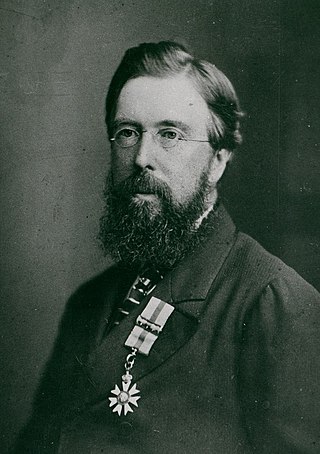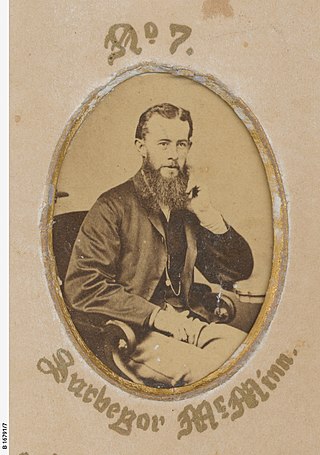
Darwent & Dalwood was a partnership of Joseph Darwent and William Dalwood put together expressly to tender for work on the Overland Telegraph Line.

Darwent & Dalwood was a partnership of Joseph Darwent and William Dalwood put together expressly to tender for work on the Overland Telegraph Line.
Accountant Joseph Darwent (c. 1824 – 20 October 1872) arrived in South Australia aboard Posthumous in June 1849 in the employ of the South Australian Railway Company, an English company touting for the contract to build a railway from Adelaide to the Port. This company amalgamated with others, to form the successful bidder, Adelaide City and Port Railway Company, of which Darwent was appointed secretary. However, by October 1851 the under-capitalised company had abandoned the project, and the Government revoked the agreement and took over construction. The first train ran on the line in 1856; the first Government-owned railway in the British Empire.
When his position at the Railway Company ended in 1851 Darwent joined the gold rush to Victoria and made a series of gold strikes in the Bendigo region that left him, "556 Pounds the richer". He returned to Adelaide and embarked on business as a shipping and stock agent with an office in Grenfell Street, as well as a wheat and flour merchant, managing for a while to corner the trade in those commodities between Adelaide and Britain and to the Americas. He was a founder of the South Australian coastal steamer trade between Port Adelaide, Wallaroo, Port Lincoln and Port Augusta, with ships Coorong, Aldinga, Omeo and Gothenburg on his books. [1] Darwent's nephew William Royse (6 April 1838 - 10 August 1892), born in Sheffield, was in Adelaide by 1859, [2] and in 1861 was in Dunedin, New Zealand, acting as shipping agent for Darwent's steamship Maid of the Yarra, [3] [4] capitalising on the burgeoning trans-Tasman trade resulting from the Otago gold rush.
Darwent married Eliza Atchison (c. 1829 – 12 March 1885) in 1852; their children included Frederick Arnold (1854), James Thornhill (1858), Frank Atchison (1859), Lucy Harriet (1861), Charles Beauchamp (1863).
Another nephew, metallurgist Joseph Darwent, jun. (1847 – 10 August 1926), born in Sheffield, married Winifred Teresa Kelly (c. 1850 – 7 January 1941) on 16 May 1869. He was a draughtsman on the telegraph line for Darwent & Dalwood. [5] He found gold 151 miles (243 km) south of Port Darwin in 1871, [6] but priority was disputed. [7] [8] He later had a property near Coonawarra, lived in Penola, where he was a member of the District Council for 35 years and chairman for 25.
William Trevett Dalwood (c. 1834 – 22 August 1909) arrived with his parents Caleb (c. 1810 – 25 September 1851) and Hannah Dalwood, née Trevett ( – 27 August 1878), a newborn brother Theophilus (died 1847) and sisters Sarah Ann (later Lethaby), Elizabeth Jane (later Baum), [9] Achsah Mary Dalwood (married Ralph Drummond), in September 1840 aboard Lysander. Youngest son Thomas Caleb (died 1909) was a prolific portrait painter. Caleb was licensee of Park Gate Hotel, Goodwood; Hannah ran it for four years after his death.
His first employment was with a pair of oxen carting water, Adelaide not yet having the luxury of reticulated water. His business expanded to carting stone, for which there was a huge appetite, for the construction of buildings and for laying roads. He expanded his operations to quarrying and thence to mining. He was soon a director of half-a-dozen mining companies,
Dalwood married Emma Frearson on 6 September 1855. Her father was also a contractor, and in 1860 Dalwood's assistant. Their children included Frederic William, William, Augustus George, George Trevett Palmerston, Britannia Frances, Silva, Georgia Blanche, Olive Lavinia, Eva Beatrice and Constance Louise Gertrude; they had a home on Melbourne Street, North Adelaide.
On 20 August 1870 SS Omeo left McLaren wharf, Port Adelaide with passengers W. A. Paqualin (supervisor), Joseph Darwent, jun., Stephen King, Charles Tym (another of Darwent's nephews), William Dalwood, and Government officers William McMinn (Overseer of Works), R. C. Burton (his assistant), J. L. Stapleton, and A. Hawley, [10] and 75 laborers engaged by Darwent & Dalwood in steerage. Dalwood was present only as an observer, and was a passenger on the return voyage. Omeo also carried 80 draught horses, a dozen head of cattle (whether beef cattle or working bullocks was not mentioned), and provisions for the journey. In the hold were over 1,000 bundles (50) of galvanised iron telegraph wire, 3,000 insulators and other hardware.
Omeo arrived safely on 9 September, berthed at Port Darwin and was promptly unloaded. A telegraph pole was ceremoniously erected by a daughter of Capt. Bloomfield Douglas, the Government Resident. A month later, all was good news and optimism: 60 miles (97 km) of line had been erected, and work was progressing at 15 miles (24 km) per week, [11] expecting completion in eight or nine months. [12] Another 50 tons of wire and 3,528 insulators were despatched in February, with only the last 50 tons of wire to be shipped. In June it was anticipated the northern section would be completed ahead of time, and they could continue southward and do some of the central section. [13]
It therefore came as a shock to people in Adelaide to learn that Overseer of Works (northern section) McMinn had taken the extreme action of cancelling Darwent & Dalwood's contract as from 3 May, and had sent all their workers back to Adelaide, on the basis of their falling so far behind that there was no prospect of completion by 1 January 1872. [14]
The sacking of the workers by McMinn was on the basis of an insurrection, denied by the men. [15]
In May 1875 William Dalwood brought his case for compensation before the Chief Justice and a special jury, arguing that his company had been sacked without just cause; that they could have completed the work by the deadline. His claim was denied on the grounds that he was precluded by the terms of the contract from disputing the judgment and determinations of the Overseer of Works. He was awarded £10,000 on the value of work done. (Cost to the government for their work was around £100,000 and took 18 months.)

Sir Charles Todd worked at the Royal Greenwich Observatory 1841–1847 and the Cambridge University observatory from 1847 to 1854. He then worked on telegraphy and undersea cables until engaged by the government of South Australia as astronomical and meteorological observer, and head of the electric telegraph department.

George Woodroffe Goyder was a surveyor in the Colony of South Australia during the latter half of the nineteenth century.

The Australian Overland Telegraph Line was an electrical telegraph system for sending messages the 3200 kilometres between Darwin, in what is now the Northern Territory of Australia, and Adelaide, the capital of South Australia. Completed in 1872, it allowed fast communication between Australia and the rest of the world. When it was linked to the Java-to-Darwin submarine telegraph cable several months later, the communication time with Europe dropped from months to hours; Australia was no longer so isolated from the rest of the world. The line was one of the great engineering feats of 19th-century Australia and probably the most significant milestone in the history of telegraphy in Australia.

Australia was a relatively early adopter of electrical telegraph technology in the middle of the nineteenth century, despite its low population densities and the difficult conditions sometimes encountered in laying lines. From 1858 onwards, the major capitals were progressively linked, culminating in the addition of Perth in 1877. Australia was linked to the rest of the world for the first time in 1872, through the Overland Telegraph which ran some 3,200 kilometres (2,000 mi) from Adelaide through to Darwin. The network continued to expand in size and sophistication until 1959 and in heavy usage until 1945, after which time telephone usage began to erode public patronage of telegraphy services. The final publicly provided telegraphy service was closed in 1993.

William McMinn was an Irish-born Australian surveyor and architect, based in Adelaide in the colony of South Australia.
Stephen King was an English sketcher, surveyor, and explorer. He was part of the last John McDouall Stuart Expedition (1861–1862), successfully crossing Australia from south to north, and was appointed Surveyor of the Overland Telegraph party sent out by Darwent and Dalwood in 1870. He was called Stephen King Jr. during the lifetime of his father, a pioneer of Gawler, and to a lesser extent continued through his life. His father has been called here and elsewhere Stephen King JP.

Alfred Giles, born in Datchet, England, was a South Australian bushman, drover and explorer who crossed Australia from south to north seven times, mostly in connection with the building of the Overland Telegraph Line 1870–1872.

Captain Samuel White Sweet was an English sea captain who settled in Australia in 1864, and was involved in the early colonization of the Northern Territory. After the grounding of his ships Gulnare and Wallaroo, for both of which he was held culpable, he turned his interest in photography from a serious hobby and part-time occupation to a profession. Sweet was a pioneer of Australian landscape photography as an art form, and kept abreast of technical advances in the medium.
Henry Jones was a photographer remembered for his portraits of pioneer settlers of South Australia. He was the father of the organist T. H. Jones.

The Alice Springs Telegraph Station is located within the Alice Springs Telegraph Station Historical Reserve, four kilometres north of the Alice Springs town centre in the Northern Territory of Australia. Established in 1872 to relay messages between Darwin and Adelaide, it is the original site of the first European settlement in central Australia. It was one of twelve stations along the Overland Telegraph Line.

Gilbert Rotherdale McMinnCE, SM, was an Australian surveyor born in Ireland noted for his work in the Northern Territory surveying the Overland Telegraph Line. His middle name is occasionally spelt "Rutherdale".
Willalooka is a small service town and locality in the Limestone Coast region of South Australia. it is located on the Riddoch Highway between Keith and Padthaway. Christmas Rocks Conservation Park is north of the town adjacent to the highway.
John Ralph Hansford Ward, invariably known as Hansford Ward or Captain Ward, was a ship's captain in South Australia, who figures prominently in the pre-history of the Adelaide Steamship Company. A son, also named John Ralph Hansford Ward but known as John R. H. Ward, was also a ship's captain.
The Frearson brothers, Samuel, Septimus and Robert were businessmen and publishers in the early days of Adelaide, South Australia, perhaps best remembered for The Pictorial Australian, an illustrated monthly newspaper.
Dalwood is an English language surname. People with this name include:
Forlorn Hope was the name given by a group of seven men to an open boat in which they sailed and rowed from Adam Bay, Northern Territory to Champion Bay, Western Australia, a distance of some 2,000 miles (3,200 km) in May–August 1865.
Several survey parties were sent by the South Australian Government to the "Top End" of the Northern Territory during the years 1864–1870, preparatory to founding a settlement. This article describes those attempts and the people involved. It includes lists of all known participants.

Richard Randall Knuckey, often referred to as R.R. Knuckey and popularly known as Dick Knuckey, was a surveyor on the Overland Telegraph Line in central Australia from 1871 to 1872. He later became chief officer at the electric telegraph department in Adelaide.
James Dominick Woods, generally referred to as J. D. Woods or J. D. Woods sen., was a South Australian journalist and author of the first official history of South Australia and a history of the colony's first Royal Visit. He served as returning officer for two electorates. Five sons were Australian rules footballers.

William Royse was a Dunedin-based businessman active in New Zealand from 1861 until his death in 1892.